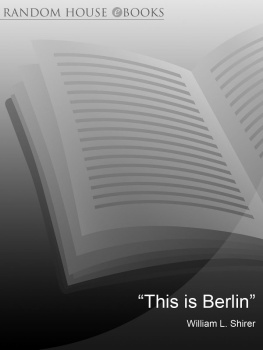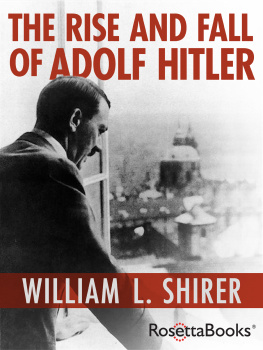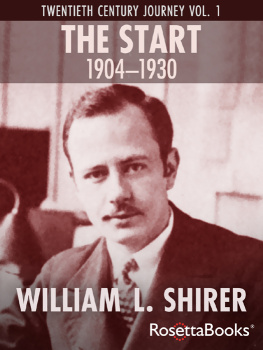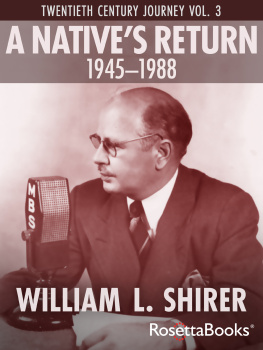The Nightmare Years, 19301940
Twentieth Century Journey Vol. II
William L. Shirer
Copyright
The Nightmare Years, 19301940
Copyright 1984, 2014 by William L. Shirer
Cover art, special contents, and Electronic Edition 2014 by RosettaBooks LLC
All rights reserved. No part of this book may be used or reproduced in any form or by any electronic or mechanical means, including information storage and retrieval systems, without permission in writing from the publisher, except by a reviewer who may quote brief passages in a review.
Cover jacket design by Alexia Garaventa
ISBN e-Pub edition: 9780795334269
To
Deirdre, Caitlin,
Christina, and Alexander
May the world of these grandchildren have peace.
The end and the beginning of beings are unknown. We see only the intervening formations. Then what cause is there for grief?
BHAGAVADGITA
We know little of the past and nothing of the future, and the present is so immense that it exceeds our range of experience.
RADHAKRISHNA, PARAPHRASING SANKARA
Introduction
For me, as for millions of others on this small globe, the decade 19301940, with which these memoirs deal, was a time of growing upheaval. My work as an American foreign correspondent in Europe and Asia became more and more concerned with revolutions, uprisings and a spreading intolerance, violence, repression, aggression and barbarism in supposedly civilized countries. One watched it all leading inexorably toward war.
These were the nightmare years. I was twenty-six when the decade began. For the previous five years, ever since arriving in Paris fresh out of a small Iowa college, I had worked as a newspaperman in most of Europes great capitals, sensing the crumbling of the old order, of the gradual breakdown of the structure of peace set up by the victorious Western democracies at Versailles in 1919 on the conclusion of the Great War.
The status quo in Europe was being challenged by the totalitarian dictatorships, of the left and rightStalins Bolshevik Russia, Mussolinis Fascist Italyand by the sudden rise of Hitler in Germany as the 1930s began. It was also being undermined by the onset of the Depression, with its massive unemployment, failing banks and businesses, falling currencies and spreading hunger.
Still, there had been a decade of peace after the terrible bloodletting of the war, and a certain well-being of the people, weary from so murderous a conflict. In Paris, full of so much light and beauty, which I had come to passionately love, but also in London, Rome, Vienna and Geneva (the site of the League of Nations), I had covered the news for the Chicago Tribune. It had been an interesting lifeand a great educationfor a nave, ignorant young American.
Then one August day in 1930 in Vienna, where I was then stationed, I received a curt cable from Colonel Robert Rutherford McCormick, the eccentric publisher of the Tribune, ordering me to fly out to India. Mahatma Gandhis Civil Disobedience movement was threatening British rule there and rocking the foundations of the Empire. Gandhi was emerging as a unique figure, preaching a new kind of revolution through nonviolent noncooperation with British authority, tramping about the country in a loincloth to arouse his fellow Indians from the torpor they had sunk into during centuries under the foreign yoke. To most Indians Gandhi had become a saint and a savior. To some in the West he was a Christ-like figure, caring for the poor, practicing what he preached. Deeply religious, Gandhi was also a shrewd politician and a charismatic leader.
Of all the world leaders, he had already struck me as the greatest and the most original. I was anxious to talk to him and to try to understand him and the revolution he had launched. That experience and his impact on me, on India, on the British, and indeed on the world, I have described in GandhiA Memoir.
***
I lingered on in Asia, going up the Khyber Pass to Kabul, the capital of primitive, tribal Afghanistan, to see a new king establish himself after another bloody civil war, then traveling overland back to Europe through Mesopotamia, Syria and Turkey, stopping at such places as Ur, Babylon and Bagdad, meeting with some adventure in these faraway, seething areas and in Ur stumbling across two of the greatest archaeological discoveries of our time.
Back in Vienna, I married, got fired, took a year off in a Spanish fishing village, where I watched the fledgling Spanish Republic falter, read in the newspapers of Adolf Hitler taking over in Germany, wrote my first book, which was unpublishable, returned to Paris in time to cover a Fascist assault (backed by the Communists) on the Third Republic and the bloodiest rioting on the Place de la Concorde since the Communeand at the end of the summer of 1934 I went on from there to Berlin.
***
This was, as it turned out, a fateful move for me. It determined my life and work for years to come. Like the experience with Gandhi, it left an indelible impression on me. Recounting it fills the bulk of the pages of this memoir.
With increasing fascination and horror I watched Hitler crush freedom and the human spirit in Germany, the country of Luther, Kant, Beethoven, Goethe and Schiller, persecute the Jews and prepare to massacre them, destroy all who opposed him, and drag this great nation toward war, conquest and destruction. To my consternation most Germans joined joyously in this Nazi barbarism.
I left Germany in December, 1940, fifteen months after Hitler plunged Europe into war. As a war correspondent I had followed the German army through some of its early campaigns, in Poland and in the West, reporting on how it had revolutionized modern warfare with the Blitzkrieg, in which an overwhelming concentration of tanks and planes on a narrow front would break through the enemy lines, cut off and surround whole armies, and quickly annihilate them. When I departed Berlin, German troops, after their quick and easy conquests of Poland, Denmark, Norway, Holland, Belgium and France, stood watch from the North Cape to the Pyrenees, from the Atlantic to beyond the Vistula. Britain stood alone. Few doubted that Hitler would emerge from the conflict as the greatest conqueror since Napoleon. Not many believed that Britain would survive.
But history, as it does so often, took an unexpected turn. The Nazi dictator, spoiled by early success, overreached himself. He turned on Russia, which under Stalin had been his virtual ally, and then he took on the United States, which had largely held aloof. These were potentially the two most powerful nations on earth. Dragging them into the war against him sealed Hitlers fate.
***
At the wars end in 1945, I was back in Germany to survey the ruins and to try to find out at first hand how the Third Reich had reached its sorry end.
Berlin, the once proud capital, was a mass of rubble, indescribable in its desolation. So were most of the other cities of Germany. The German people, so arrogant over their conquests when I had last seen them, were shivering, hungry and homeless, struggling only to survive the first miserable winter of peace. Hitler was dead, a suicide, as were two of his closest henchmen, Goebbels and Himmler. Seven million Jews and a like number of SlavsPoles and Russianswere also dead, massacred in cold blood by the leaders of this Christian country. Gring, Ribbentrop, Rosenberg, Hess and most of the other men around Hitler were alive, imprisoned at Nuremberg, awaiting trial as Nazi war criminals. I went down to Nuremberg to see them in the dock, to follow the first weeks in the courtroom, and to reflect on the ups and downs of history, of which these memoirs have been so full. I felt that in this case, justice after all, for once, had caught up with the perpetrators of some of the most coldblooded and massive crimes men had ever committed. One seldom lived to see that happen. I had not believed, in the despairing years I labored in Berlin, that I would ever see it.










